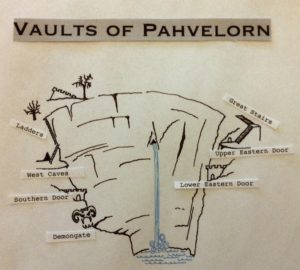
Every once in a while, but with some regularity, someone will ask for module recommendations, often as a way to get into old school or classic play. I am somewhat conflicted regarding the best response to such requests because, while there is nothing fundamentally wrong with modules, and they have some particular utility, modules are also limiting, often have poor handling, and are poor examples of the form’s potential.
My inclination is to instead suggest that referees, even new referees, create a simple custom scenario. This is unnecessarily intimidating, partly due to some unfortunate ingrained assumptions, including seemingly upward comparison to professional offerings with illustrations, cartography, edited prose, and so forth. In reality, crafting a satisfying classic scenario is often less complicated than the process of building a player character in a contemporary system, but has become obscured by a shroud of world building complexity and the detritus of expectations related to literary story structure. There are a few examples of procedures that a referee can follow to create a scenario, such as Moldvay’s double spread in 1981 Basic D&D (pp. B51-B54) which explains how to create an adventure. The recent Old School Essentials SRD provides similar information, available for free online (adventure scenarios, designing a dungeon, designing a wilderness). Other resources exist as well, though often buried in other materials.
These resource are useful, but still often seem to be pitched at the wrong level, lacking sufficiently concrete set of recommended actions, or attached to bland thematic content. As an example of the kind of referee rules that I think would be an antidote to module recommendations, I want to highlight two recent blog posts about crafting megadungeons:
- Papers & Pencils: Two Week Megadungeon
- Swamp of Monsters: How I Did My Megadungeon
The Two Week post in particular is a practical and clear example, though perhaps still slightly intimidating for a starting referee. Unfortunately, the trappings of a megadungeon is probably mildly counterproductive, despite the likely truth that following Nick’s megadungeon building guidelines would probably be easier and more enjoyable than skimming B2, or just about any published module scenario. (In reality, the observant and experienced reader will also note that a megadungeon is really just a series of linked scenarios that happen to be subterranean.)
If you are aware of any other similar scenario building procedures worth highlighting, drop them in the comments. Procedural rules rather than something like a collection of tables would be most useful. I am sure I am neglecting some other good resources. This is also a call for what to include in a game’s referee book or section.

The Into The Odd: Electric Bastionland GM section has one of the best adventure design guides I’ve ever seen, especially for sandbox OSR play.
Couldn’t agree more with this post. It would do the hobby a lot of good to have more concrete, practical procedures/resources like this.
One example of this, however, is Kevin Crawford’s adventure creation guidance in (particularly) Stars Without Number and Wolves of God. Looking forward to his D&D-esque fantasy game that he’s working on, I imagine it will have similarly excellent GM sections.
I’ve read this recently- a five-week (in-your-free-time, supposedly) program adapted from an article that Gary Gygax wrote in 1975 to go over for a new GM the process of creating a new setting.
It may be a little more in-depth than you are aiming for here, but it is laid out nicely. Here’s a link to it (free download):
https://rayotus.itch.io/gygax75
The first week covers getting the feel for the setting and collecting inspiration.
The second week fills in the bones of a hexcrawl.
The third week creates three levels of a dungeon.
The forth week details the main town.
The fifth week contains a bunch of extra activities to add depth.
The author and a friend playtested the method, results here:
https://plundergrounds.blogspot.com/search/label/Gygax%2075%20Challenge
@Thomas
Very nice. That looks like a solid outline procedure.
Arnold’s Dungeon Checklist has been the most helpful guide for me. Following his advice has significantly upgraded the quality of the dungeons I make:
http://goblinpunch.blogspot.com/2016/01/dungeon-checklist.html
I appreciate you posting this. Yes, putting together your own material seems like more work, but can be vastly more ENJOYABLE than reading and familiarizing yourself with someone else’s adventure. For whatever reason, I find reading pre-written adventures to prepare for play to be grueling at times. I don’t know if others feel the same…
Late to the party, but I really agree. The surprising thing is that TSR didn’t release such a manual – instead they sold us guff like Wilderness Survival Guide and Dungeon Survival Guide. I would have thought that by now an ex-employee would have released any in-house adventure design guides but then the range of adventures and the variable quality suggests that there wasn’t an internal design guide. The U.K. adventures are perhaps the most consistent in their execution.